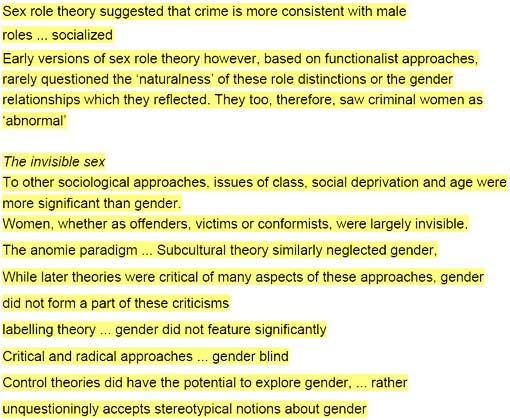4 Taking the point: identifying key ideas
As earlier activities have demonstrated, active reading and note taking often come hand-in-hand. In order to read effectively we often have to jot down the main ideas and key words introduced in the text. We might also note down one or two questions as we go along to assist in the ‘thinking’ part of the process. But, like reading, note taking comes in all shapes and sizes, and different kinds of notes can be useful for different purposes. Moreover, good note taking, like purposeful, active reading, involves a series of processes from highlighting key ideas in the text to constructing more complex diagrammatic representations of the main points.
By reading in an active way you have already begun to identify key ideas presented in a text and perhaps even jot them down. However, an alternative method of identifying key ideas is to use a highlighting technique. This involves actually marking important parts of the text by underlining or using a highlighter pen and thus creating a more permanent reminder of key ideas. This approach is designed to promote selectivity and encourages you to focus on the core meanings of an extract. However, before you have a go, you should take note of the following warnings:
Highlighting involves you making judgements about what is important. It is not about capturing every detail but, rather like scanning, is about getting a general overview of the big ideas. Do not be tempted to highlight everything or nearly everything – this renders the exercise pointless as you will be no better off with everything underlined than you were with nothing underlined.
A good rule of thumb is to underline or highlight one sentence per paragraph. Paragraphs usually focus on one key point, and while they might include an illustrative example which may be useful, it is the main point that you need to identify first and foremost. Some people find it more useful, then, to add in a short note of the example in the margin next to the highlighted sentence.
Do not see highlighting as the end of the process – an alternative to full note taking. It is merely the first step. Highlighting does not organize points into any order that makes sense to you. Nor can you use highlighted sections to reorganize ideas around themes or in answer to assignment questions.
Activity 6
Read through the extract from Hazel Croall's book again, this time identifying and highlighting the key ideas. This will be easier now that you have already read through the text once before. In fact, the best highlighting is often achieved on a second reading.
You will find our feedback and comments noted in the "Now read the discussion" link beneath the article. Try not to read these until you have completed the activity.
Click below to open the extract by Hazel Croall, Crime and society in Britain.
crime and society in Britain [Tip: hold Ctrl and click a link to open it in a new tab. (Hide tip)]
Discussion
We highlighted the following parts of the text:

We highlighted these introductory sentences as they seemed to capture the key focus of the extract – different conviction rates for men and women, what they might mean and how they might be explained.
We thought it was important to highlight that the trends discussed in the article were based on conviction rates as opposed to any other measure -these six words will be enough to remind us of that so we did not feel it was necessary to mark the whole sentence.

We felt that these sentences were important as they summarized the main trends for men and women, based on conviction rates. We didn't highlight the statistics presented or details about particular offences committed. This is because the technique of highlighting is a way of identifying key ideas. We can go back to the text and extract more detailed information, perhaps using a skimming technique, at a later date if we find that we need to. Alternatively, if we decide to take more detailed notes about the whole of the extract, say in preparation for an assignment, this material would be included there.
This sentence seemed important to us as it suggests that the trends may say more about the conviction process, for example, than actual crime rates.

The first of these sentences summarizes one particular approach to explaining women's apparent lack of criminality, whereas the second gives useful examples of the kinds of factors seen as important to those writing from this perspective.


Early versions of sex role theory however, based on functionalist approaches, rarely questioned the ‘naturalness’ of these role distinctions or the gender relationships which they reflected. They too, therefore, saw criminal women as ‘abnormal’

Similarly, these sentences all summarize a number of alternative approaches whilst signalling possible weaknesses with them. You might have noticed that we have also highlighted sub-headings as we have gone along. This is because the author introduces different issues as well as different explanatory approaches to the same phenomenon – in this case crime. To signal where these are placed in the text can be helpful for when we return to the article at a later date and/or for when we want to generate a set of handwritten notes about the piece. Indeed, it is to this issue of making short notes that we can now turn.
